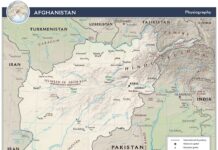Context

As the saga of Prime Minister Gilani’s contempt case continued, some other crucial developments were taking place in the region. The first ever Bangladesh-US security dialogue was initiated on April 19th in Dhaka, the same day the country bowed out of its cricket tour to Pakistan even after assurances. Coincidentally, India lunched its Agni-V long-range ballistic missile, which it claims to be an Inter-Continental Ballistic Missile (ICBM), on April 19th as well. While the domestic political scene of Pakistan is moving excruciatingly slow, the nature of its external security environment remains as dynamic as ever and is shifting from the realms of land, sea and air, to the final frontier, space.
Analysis
Indian Space Program
After the April 19th Agni-V test, India launched the RISAT-1 radar imaging satellite on April 26. RISAT-1 usefulness will be in disaster prediction and for agriculture, forestry and defense purposes. However, Chinese media has called it a spy satellite. Not long ago, in 2009 India had acquired Israeli manufactured RISAT-2 that has night scanning capability. The capabilities of these satellites make them instrumental in monitoring the moves of unfriendly neighbors such as Pakistan and China 24/7. Reportedly, India has the world’s highest number of remote sensing satellites (11) in orbit and is a leader in the remote sensing data market.
These recent moves are part of Indian focus to modernize its military based on cutting-edge warfare strategies and tactics, such as the Network Centric Warfare (NCW). This ambition was reflected in the comments made by Indian Army Spokesman Colonel Jagdeep Dahiya, as he talked about the large-scale military exercise Shoorveer (Brave Warrior) that is presently ongoing,
“Battlefield transparency and operational plans based on real-time situational awareness will be enhanced using intelligence, surveillance, and reconnaissance (ISR) input from Unmanned Aerial Vehicles (Drones), radars and satellites,” he stated.
Space-based assets have become an integral part of a strategy to maintain a control and dominance over land, sea and air. All leading world powers are in the process of developing technologies for its surveillance, through Space Situational Awareness (SSA) and Anti-Satellite (ASAT) capabilities. Mainly because the geospatial intelligence, missile defense systems, global positioning and targeting mechanisms used by ground and air forces, are dependent on these satellites.
India has also shown interest in developing Anti-Satellite (ASAT) weapons. According to the Indian media, this focus developed after China’s 2007 use of an ASAT weapon to destroy an old satellite. The Director General of Indian Defense Research and Development Organization (DRDO) VK Saraswat had stated in 2010,
“India is putting together building blocks of technology that could be used to neutralize enemy satellites. We are working to ensure space security and protect our satellites. At the same time, we are also working on how to deny the enemy access to its space assets.”
Moreover, India performed its latest test for Anti-Ballistic Missile System in February. The nation successfully tested the interceptor defense shield, which detects and destroys incoming ballistic missiles. DRDO jointly developed the system’s tracking and fire control radar with Israel and France. India is the fifth state to achieve this missile defense technology.
While India conducted its Agni-V test and launched the RISAT-1 satellite, Pakistan successfully tested a nuclear capable-intermediate range ballistic missile Hatf IV (Shaheen-1A) on April 25th. The exact range of the missile was not announced. A few unconfirmed media reports have claimed the range to be around 4,500 km. On April 26th, Pakistan had also commissioned its first fast attack craft, PNS Azmat, built in cooperation with China.
“Its immense firepower coupled with stealthy features makes it a real versatile platform which would not only prove vital for ensuring the effective presence in our area of operations but would bring a new dimension of operation of stealthy platform of this tonnage,” Admiral Muhammad Sandila of Pakistan Navy stated at the commissioning ceremony.
Pakistan’s Counter Strategy
The key word in Pakistan’s strategy to counter Indian space advancements is ‘stealth’. While Pakistan’s space program (SUPARCO) and capabilities have remained highly secretive and limited, the country has focused on developing stealth missiles and technologies to avoid detection by Indian missile defense system. This, in addition to concerns of Chinese getting access, were perhaps the reasons the US was emphatic about the return of its stealth Black Hawk helicopter that went down in Abbottabad during the Osama operation.
In October last year, Pakistan tested a stealth cruise missile, Hatf VII (Babur). The Hatf VII is speculated to be a copy of American Tomahawk cruise missile. A few of these missiles had crashed in Pakistani territory in 1998 when the US targeted militant camps in Afghanistan, in retaliation for the attack on its embassies in Kenya and Tanzania. Hatf VII has a range of about 700 km and is capable of carrying a nuclear warhead with multiple tube missile launch vehicle (MLV). MLV considerably increases the targeting and deployment options. The country is also reportedly working on a stealth version of its fighter jet J17 Thunder.
Pakistan has adopted a strategy similar to Russia, to counter the controversial American missile defense system being deployed in Europe, and other regions of the world. Russian ICBMs are equipped with Multiple Independently Targeted Reentry Vehicles (MIRV), which makes the Anti-Ballistic Missile Systems (ABMs) ineffective. Commander of the Russian Strategic Missile Forces Lieutenant General Sergey Karakayev stated in May 2011 that the new Russian RS-24 ICBMs will become ‘invincible’ as they will be capable of overcoming any missile defense system for the next 15 or 20 years.
In short, the scope of Pakistan-India rivalry that was once limited to land, sea and air, have now clearly entered the domain of space. Although major world powers are against the militarization of space, they are nonetheless not reticent in outdoing each other in space, the final frontier. It is not a matter of choice but survival.



